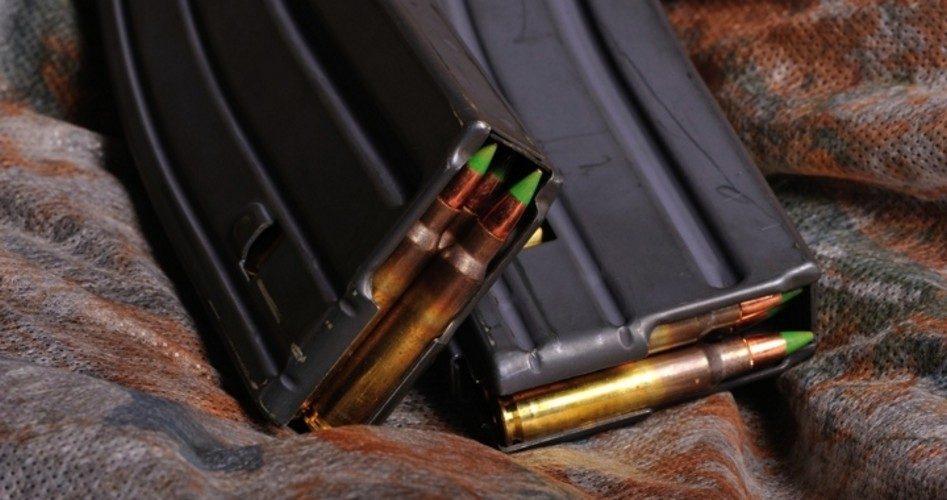
On Monday afternoon, lawmakers in Connecticut announced success in molding a bi-partisan approach to gun violence following weeks of closed-door negotiations. It will be voted upon on Wednesday, and is expected to pass the Democrat-controlled General Assembly with ease.
Rather than focus on improving security at schools, lawmakers instead turned their attention to the firearms used in recent shootings, concluding that certain features of those firearms enhanced the ability of deranged shooters to kill unarmed innocents.
For example, magazines containing more than 10 rounds are to be banned altogether, while those remaining legal must be registered with the state. The so-called “assault weapons” ban already in place will be extended to include more than 100 additional firearms, including any that have military-type features that have nothing to do with their operational effectiveness.
There is at least one “loophole” in the law that has incensed gun controllers: the “grandfathering” of magazines already in the hands of law-abiding citizens. They will not be included either in the ban of high-capacity magazines or in the requirement to have them registered by the state. As draconian as the new laws will be, they’re not enough for Mark Barden, whose 7-year-old son Daniel was killed in the Newtown shooting:
[The new law] doesn’t prevent someone from going out of the state to purchase them and then bring them back. There’s no way to track when they were purchased, so they can say: “I had this before [the new law was effective].” So it’s a big loophole.
So gaping was the loophole that Barden and other parents affected by the Newtown shooting wrote to legislators about it, saying,
The Sandy Hook shooter carried 10 magazines that held 30 bullets each. We now know that he left many smaller magazines at home. He fired 154 shots in approximately 4 minutes, killing 20 children and 6 educators. Miraculously, in the time that it took him to reload in one of the classrooms, 11 children were able to escape and are alive today.
We are left to wonder, what if the Sandy Hook shooter had been forced to reload not six times but 15 times. Would more children, would our children, be alive today?
While it is a devastating tragedy that Barden, among many others, lost a child during the massacre last December, his suggestions would not have prevented the horrific death toll. Faulty assumptions, poor logic, and ignorance of facts frame the letter. First of all it assumes that somehow it’s OK for a shooter to enter a gun-free zone and start murdering unarmed innocents as long as he uses limited-capacity magazines. Secondly it assumes that during the time it takes for this vermin to reload, someone with a brain and a backbone will seize that moment to tackle the shooter and end his rampage, or people will be able to run to safety. But a quick look at this video will put that assumption to rest permanently. One doesn’t even have to watch the entire 13 minutes to be persuaded that a shooter can load and fire two 15-round magazines or three 10-round magazines just as quickly as he can fire a single 30-round magazine. And as far as providing time for a bystander to take down the shooter between reloads, the video shows the impossibility of that strategy as well.
History and facts have consistently shown that high magazine capacities don’t lead to more deadly shootings. Guy Smith has been publishing and updating his Gun Facts for years, and his latest version 6.2 on page 76 exposes the fallacy:
The number of shots fired by criminals has not changed significantly even with the increased capacity of handguns and other firearms. Indeed, the number of shots from revolvers (all within 6-8 round capacity) and semi-automatics were about the same: 2.04 vs. 2.53.
Emily Miller agreed, noting in her January article in the Washington Times that assailants, on average, fire fewer than four shots during a criminal attack, well within the capacity of most magazines, even after the new limits are signed into law in Connecticut. Lawrence Keane, general counsel to the National Shooting Sports Federation, said that “studies prove that the arbitrary magazine capacity restriction that was in place [during the Clinton years] did not reduce crime.”
In fact, there seems to be no logic or reason behind a magazine limited to carrying 10 rounds. If 10 rounds effectively reduced crime, why not limit magazines to seven rounds, or five rounds, or three rounds? As Miller points out, the 10-round limit was just pulled out of the ether:
Many firearms come from the factory with devices that feed between 15 and 30 rounds — some hold more, some less, depending upon their configuration and purpose. Ten is a number chosen out of thin air for reasons of political theater.
Another point to be made from the Connecticut letter: these are not limits or requirements placed on the weapons themselves, but on the individuals who own them. Especially annoying is the fact that those limits are being placed on individuals who had nothing to do with the Newtown shooting.
The letter goes on to point out the “most dangerous feature” of all firearms: the magazine itself:
The [proposed law] grandfathers existing large capacity magazines leaving a gaping loophole on, what we believe, is the most dangerous feature of an assault weapon [the magazine].
Since the magazine is an inanimate object, how can it be the most dangerous feature? Isn’t the felon pulling the trigger the most dangerous feature? Neither the letter nor the legislation says or attempts to do anything about him.
Also missing from the conversation is anything about rights guaranteed under both the federal and Connecticut constitutions to keep and bear arms. The language of the Connecticut constitution is especially revealing as it solves the riddle of how to reduce violent crime if it were simply recognized and enforced. From Article I, Section 15 of the Constitution of the State of Connecticut is this:
Every citizen has a right to bear arms in defense of himself and the state.
There, in all its glory, is the answer to shooters seeking innocents as targets: let their victims be armed and see how long such an attack will last, regardless of features or magazine size.
The problem is that gun control zealots have no interest in facts or history or proclamations of constitutional guarantees. As economist Thomas Sowell noted,
The gun control crusade today is like the Prohibition crusade 100 years ago. It is a shared zealotry that binds the self-righteous know-it-alls in a warm fellowship of those who see themselves as fighting on the side of the angels against the forces of evil. It is a lofty role that they are not about to give up for anything so mundane as facts — or even the lives of other people.
A graduate of Cornell University and a former investment advisor, Bob is a regular contributor to The New American magazine and blogs frequently at www.LightFromTheRight.com, primarily on economics and politics. He can be reached at [email protected].



